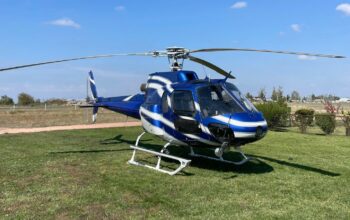The concept is simple. The solution is elegant. And the benefits are huge.
The idea of monitoring a helicopter’s dynamic components to determine the operational health of an aircraft has been around for decades.
But the complexity, high cost and weight of early-generation health and usage monitoring systems (HUMS) limited its use to large military and commercial helicopters.

That changed when Foresight MX, an all-in-one HUMS solution, was launched by GPMS International, a Waterbury, Vermont-based company.
Leveraging technological advances in computing power, new algorithms, and the cloud, GPMS created a next-generation HUMS that provides an unprecedented depth of operational knowledge paired with an easy-to-use experience.
“It’s monitoring all the dynamic components — the gearboxes, engines, bearings, drive shafts — basically, if anything moves in the aircraft, we can measure it,” said Ronnie Ries, vice president of marketing for GPMS.
Utilizing an on-board network of “smart” microprocessor sensors, the Foresight installation is over 50 percent lighter, more accurate, and with the “HUMS as a Service” model, more accessible than legacy HUMS solutions.
From the first supplemental type certificate (STC) granted for the Bell 407 in 2018, GPMS has continued to expand the list of approved installations that now includes a wide range of types and original equipment manufacturers (OEMs) — from light MD 530F and Airbus AS350/H125 series, through to Bell 212/412 medium helicopters, and right up to Sikorsky UH-60 and Boeing CH-47 heavy aircraft.
“When a customer decides to outfit their fleet with HUMS, they typically don’t just operate one type from one OEM. The ability to install a single common certified solution across a mixed fleet is hugely beneficial for efficiency,” Ries said. “One of the things we’re most proud of is how simple Foresight is to use. We’ve designed an intuitive user experience that can be accessed from anywhere in the world on any web-enabled device.”

Without the need for a pilot to interact with the system, data is sampled from the system at up to eight times per second from aircraft startup to shutdown. Once a mission is complete, Foresight automatically uploads the data to the cloud through a cellular connection.
In addition to displaying the status of a helicopter’s components — easily interpreted on the diagnostic dashboard with color-coded indicators — GPMS has designed Foresight to analyze data trends to provide an assessment of the predicted remaining useful life (RUL) of a component. “Let’s say, we’ve just detected that based on 50 hours of data, a bearing is trending toward the warning line,” Ries explained. “From that data analysis, we can tell the operator that the predicted remaining useful life of the bearing is about 70 hours. That predictive nature allows the customer to turn potential unscheduled maintenance and downtime into scheduled maintenance. The ability to forecast the need for parts then becomes streamlined, hopefully reducing the impact of parts shortages and supply chain issues.”
And when Foresight signals an issue with a component, it can simplify the troubleshooting process, giving maintenance engineers additional insight that can speed up a helicopter’s return to service.
Foresight also features integrated flight data monitoring, capturing over 60 different flight parameters. Mission data can be viewed using Foresight’s flight visualization tool, downloaded, or transferred via API for further analysis.
This element of Foresight brings comprehensive flight operations quality assurance (FOQA) to an operator by combining flight data monitoring with HUMS mechanical diagnostics and detailed exceedance documentation.
“If the HUMS system tells you how healthy your aircraft is, the flight data monitoring tells you how ‘healthy’ your pilots are flying,” Ries said. “The system will also send proactive alerts of any exceedances by text message or email.”
The extensive dynamic component dataset continuously captured by Foresight drives a feature that customers have found gives an immediate return on their investment — the process of rotor track and balance (RTB) optimization.

“Typically, when you’re getting a lot of vibration in the cabin, it’s because you’re out of balance, so you bring in the mechanics when you land,” Ries said. “They put expensive equipment on, and the pilot goes out on a test flight. They land, the mechanics make an adjustment, then another test flight, and then maybe more adjustments and more test flights. It can take anywhere from several hours to several days to get it done.”
With Foresight’s analytics and recommendations, “every time you land, not only do you know exactly how in balance you are, but you’ll see what adjustments to make to reduce vibration and improve RTB. It can dramatically reduce the number of test flights, and cost.”
For many years, bringing a cost-effective, powerful, and lightweight HUMS to all helicopter operators has been the focus of Eric Bechhoefer, CEO, co-founder, and chief engineer of GPMS.
Recognizing the development of Foresight MX and his years of leadership in expanding the use of HUMS, the Helicopter Association International presented Bechhoefer with the 2023 Salute to Excellence Award for Safety.
“GPMS’s industry leading knowledge, experience, and technology have produced the most advanced HUMS solution available,” Ries said. “With Foresight, you can know it before it matters.”









